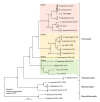Reorganized Genomic Taxonomy of Francisellaceae Enables Design of Robust Environmental PCR Assays for Detection of Francisella tularensis
- PMID: 33440900
- PMCID: PMC7826819
- DOI: 10.3390/microorganisms9010146
Reorganized Genomic Taxonomy of Francisellaceae Enables Design of Robust Environmental PCR Assays for Detection of Francisella tularensis
Abstract
In recent years, an increasing diversity of species has been recognized within the family Francisellaceae. Unfortunately, novel isolates are sometimes misnamed in initial publications or multiple sources propose different nomenclature for genetically highly similar isolates. Thus, unstructured and occasionally incorrect information can lead to confusion in the scientific community. Historically, detection of Francisella tularensis in environmental samples has been challenging due to the considerable and unknown genetic diversity within the family, which can result in false positive results. We have assembled a comprehensive collection of genome sequences representing most known Francisellaceae species/strains and restructured them according to a taxonomy that is based on phylogenetic structure. From this structured dataset, we identified a small number of genomic regions unique to F. tularensis that are putatively suitable for specific detection of this pathogen in environmental samples. We designed and validated specific PCR assays based on these genetic regions that can be used for the detection of F. tularensis in environmental samples, such as water and air filters.
Keywords: Francisella taxonomy; assay; phylogeny; tularemia.
Conflict of interest statement
The authors declare no conflict of interest. The funders had no role in the design of the study; in the collection, analyses, or interpretation of data; in the writing of the manuscript, or in the decision to publish the results.
Figures





Similar articles
-
Genomic characterization of Francisella tularensis and other diverse Francisella species from complex samples.PLoS One. 2022 Oct 12;17(10):e0273273. doi: 10.1371/journal.pone.0273273. eCollection 2022. PLoS One. 2022. PMID: 36223396 Free PMC article.
-
Detection of diverse new Francisella-like bacteria in environmental samples.Appl Environ Microbiol. 2005 Sep;71(9):5494-500. doi: 10.1128/AEM.71.9.5494-5500.2005. Appl Environ Microbiol. 2005. PMID: 16151142 Free PMC article.
-
Evaluation of the Biotoxis qPCR Detection Kit for Francisella tularensis Detection in Clinical and Environmental Samples.J Clin Microbiol. 2020 Dec 17;59(1):e01434-20. doi: 10.1128/JCM.01434-20. Print 2020 Dec 17. J Clin Microbiol. 2020. PMID: 33115844 Free PMC article.
-
[Francisella tularensis--feature of pathogen, pathogenesis, diagnostics].Przegl Epidemiol. 2006;60(3):601-8. Przegl Epidemiol. 2006. PMID: 17249186 Review. Polish.
-
Francisella tularensis Subspecies holarctica and Tularemia in Germany.Microorganisms. 2020 Sep 22;8(9):1448. doi: 10.3390/microorganisms8091448. Microorganisms. 2020. PMID: 32971773 Free PMC article. Review.
Cited by
-
Proteomic Signatures of Antimicrobial Resistance in Yersinia pestis and Francisella tularensis.Front Med (Lausanne). 2022 Feb 10;9:821071. doi: 10.3389/fmed.2022.821071. eCollection 2022. Front Med (Lausanne). 2022. PMID: 35223919 Free PMC article.
-
MTSv: rapid alignment-based taxonomic classification and high-confidence metagenomic analysis.PeerJ. 2022 Nov 8;10:e14292. doi: 10.7717/peerj.14292. eCollection 2022. PeerJ. 2022. PMID: 36389404 Free PMC article.
-
Francisella sp., a Close Relative of Francisella orientalis, Causing Septicemia with Cholestatic Hepatitis in a Patient with Anti-Interferon-γ (IFN-γ) Autoantibodies.Trop Med Infect Dis. 2022 Feb 11;7(2):25. doi: 10.3390/tropicalmed7020025. Trop Med Infect Dis. 2022. PMID: 35202220 Free PMC article.
-
Atomic Structure of IglD Demonstrates Its Role as a Component of the Baseplate Complex of the Francisella Type VI Secretion System.mBio. 2022 Oct 26;13(5):e0127722. doi: 10.1128/mbio.01277-22. Epub 2022 Aug 29. mBio. 2022. PMID: 36036641 Free PMC article.
-
Detection and Genotyping of Francisella tularensis in Animal Hosts and Vectors from Six Different Natural Landscape Areas, Gansu Province, China.Comput Math Methods Med. 2021 Dec 18;2021:6820864. doi: 10.1155/2021/6820864. eCollection 2021. Comput Math Methods Med. 2021. Retraction in: Comput Math Methods Med. 2023 Jun 28;2023:9869158. doi: 10.1155/2023/9869158. PMID: 34961822 Free PMC article. Retracted.
References
-
- Qu P.-H., Li Y., Salam N., Chen S., Liu L., Gu Q., Fang B.-Z., Xiao M., Li M., Chen C., et al. Allofrancisella inopinata gen. nov., sp. nov. and Allofrancisella frigidaquae sp. nov., isolated from water-cooling systems, and transfer of Francisella guangzhouensis Qu et al. 2013 to the new genus as Allofrancisella guangzhouensis comb. nov. Int. J. Syst. Evol. Microbiol. 2016;66:4832–4838. doi: 10.1099/ijsem.0.001437. - DOI - PubMed
-
- Zheng M.-L., Jiao J.-Y., Dong L., Han M.-X., Li L.-H., Xiao M., Chen C., Qu P.-H., Li W.-J. Pseudofrancisella aestuarii gen. nov., sp. nov., a novel member of the family Francisellaceae isolated from estuarine seawater. Antonie Van Leeuwenhoek. 2019;112:877–886. doi: 10.1007/s10482-018-01220-0. - DOI - PubMed
-
- Colquhoun D.J., Larsson P., Duodu S., Forsman M. The Family Francisellaceae. [(accessed on 1 December 2020)];Prokaryotes. 2014 :287–314. Available online: https://link.springer.com/referenceworkentry/10.1007/978-3-642-38922-1_236. - DOI
-
- Penn R.L. Mandell, Douglas, and Bennett’s Principles and Practice of Infectious Diseases. Elsevier; Amsterdam, The Netherlands: 2010. Francisella tularensis (Tularemia) pp. 2927–2937.
-
- Timofeev V., Bakhteeva I., Titareva G., Kopylov P., Christiany D., Mokrievich A., Dyatlov I., Vergnaud G. Russian isolates enlarge the known geo-graphic diversity of Francisella tularensis subsp. mediasiatica. [(accessed on 1 November 2020)];PLoS ONE. 2017 12:e0183714. doi: 10.1371/journal.pone.0183714. Available online: http://www.ncbi.nlm.nih.gov/pubmed/28873421. - DOI - PMC - PubMed
LinkOut - more resources
Full Text Sources
Other Literature Sources
Molecular Biology Databases

